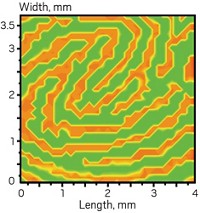Advertisement
Grab your lab coat. Let's get started
Welcome!
Welcome!
Create an account below to get 6 C&EN articles per month, receive newsletters and more - all free.
It seems this is your first time logging in online. Please enter the following information to continue.
As an ACS member you automatically get access to this site. All we need is few more details to create your reading experience.
Not you? Sign in with a different account.
Not you? Sign in with a different account.
ERROR 1
ERROR 1
ERROR 2
ERROR 2
ERROR 2
ERROR 2
ERROR 2
Password and Confirm password must match.
If you have an ACS member number, please enter it here so we can link this account to your membership. (optional)
ERROR 2
ACS values your privacy. By submitting your information, you are gaining access to C&EN and subscribing to our weekly newsletter. We use the information you provide to make your reading experience better, and we will never sell your data to third party members.
Materials
Nanotube-Based Sensor Detects Gama Rays
Partially-folded protein from barley steadies brew’s tiny bubbles
by Bethany Halford
December 14, 2009
| A version of this story appeared in
Volume 87, Issue 50
Detecting dangerous gamma rays could become simpler and less expensive, thanks to a new sensor based on a carbon nanotube-polymer composite (Angew. Chem. Int. Ed., DOI: 10.1002/anie.200904936). The technology, which relies on a simple resistivity measurement, could find practical use in national security or nuclear research, say MIT’s Timothy M. Swager and Jose M. Lobez, who created the device. The sensor is composed of a network of multiwalled carbon nanotubes embedded in a nonconductive poly(olefin sulfone) matrix. Exposure to gamma rays depolymerizes the matrix, creating low-resistance connections between the nanotubes. This, in turn, leads to an increase in conductivity in the system. Swager and Lobez employed several chemical tricks to boost the performance of their sensor. Using click chemistry, they added pyrene moieties and bismuth complexes to the polymer. The former improve the nanotubes’ dispersion, and the latter increase the system’s opacity to ionizing radiation. The new sensor produces a real-time signal at room temperature, is composed of relatively inexpensive starting materials, and has nearly zero cost of operation, the researchers note.




Join the conversation
Contact the reporter
Submit a Letter to the Editor for publication
Engage with us on Twitter